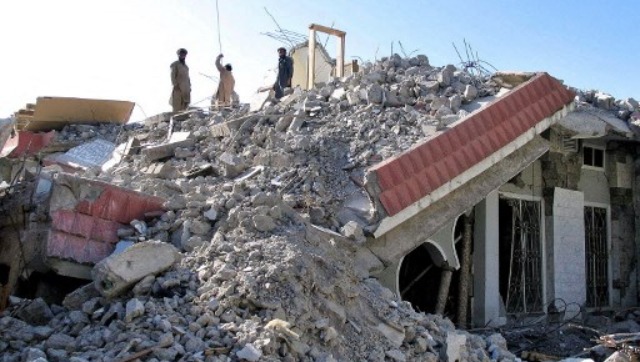A powerful earthquake early Thursday shook a remote mountainous part of southwestern Pakistan dotted with coal mines and mud houses, killing at least 11 people and injuring more than 200, an official said. The toll was expected to rise as officials search through the remote mountainous area, said Suhail Anwar Shaheen, the deputy commissioner of the area. At least four of the dead were killed when the coal mine in which they were working collapsed, said Shaheen, citing reports from coal miners in the area. The epicenter of the 5.7 magnitude quake was about 14 kilometers (8 miles) north-northeast of Harnai in Baluchistan province, according to the US Geological Survey. It struck about 20 kilometers (12 miles) below the surface. Earthquakes are known to often rattle southwest Pakistan and Baluchistan is Pakistan’s largest, but least populated province. Here’s a look at some of the other dangerous earthquakes that had shaken this region. 1905 — Kangra earthquake The 1905 Kangra earthquake occurred in the Kangra Valley and the Kangra region of the Punjab Province (modern-day Himachal Pradesh) in India on 4 April 1905. The earthquake measured 7.8 on the surface wave magnitude scale and killed more than 20,000 people. Apart from this, most buildings in the towns of Kangra, Mcleodganj and Dharamshala were destroyed. The then Punjab government had estimated that more than 20,000 persons were killed in Kangra district. Nearly 1,00,000 buildings were destroyed and 53,000 domestic animals were killed. The historical Kangra Fort and the famous Brajeshwari Temple were also destroyed, reported The Tribune. 1935 — Quetta earthquake On the morning of 31 May, 1935, a powerful earthquake devastated the town of Quetta and the adjoining areas. Nearly 35,000 people are believed to have been killed, most of those fatalities in Quetta alone. This was one of the deadliest known earthquakes in the Indian sub-continent. Tremors were felt over much of Pakistan and as far as Agra in India. Most of the reported casualties occurred in the city of Quetta. Initial communiqué drafts issued by the government estimated a total of over 20,000 people buried under the rubble, 10,000 survivors and 4,000 injured. Landmarks of all kinds have disappeared, and the city became a widespread mass of debris. An official report gives the number of killed in it as 26,000 out of a population of 40,000. 1945 — Makran earthquake A tsunami caused by a magnitude 8.1 earthquake, triggered a landslide under the ocean that generated a 15m high tsunami, resulting in the deaths of more than 4000 people along the Makran coast on 28 November, 1945. It was the second-worst tsunami event in the Indian Ocean, after the more recent 2004 Boxing Day Sumatra earthquake. The 1945 earthquake triggered a number of mud volcanoes and offshore islands formed in the same region. The clock tower at the Karachi Municipality Building stopped and the earth rumbled for approximately 30 seconds. The tremors were felt as far away as Calcutta (now Kolkata). According to the Tsunami Society, the epicenter of the quake was estimated at about 408 km SSW of Karachi and as the city settled from the initial shock, a much bigger strike would soon follow. The earthquake had generated a huge tsunami which “swept the whole of the Arabian Sea coast. The fishing village of Khudi, 48 km west of Karachi, bore the brunt of the waves and its entire population was swept away. Ormara and Pasni was hit by a 15m high wall of water which caused massive destruction, reports The Dawn. 2005 — Kashmir earthquake The Kashmir earthquake of 2005 was a disastrous earthquake that occurred on 8 October, 2005, in the Pakistan-administered portion of the Kashmir region and in the North-West Frontier Province (NWFP; called Khyber Pakhtunkhwa after 2010) of Pakistan. It also affected adjacent parts of India and Afghanistan. At least 79,000 people were killed and more than 32,000 buildings collapsed in Kashmir, with additional fatalities and destruction reported in India and Afghanistan and left more than 3 million homeless. Measured at a magnitude of 7.6, the earthquake caused major destruction in northern Pakistan, northern India, and Afghanistan, an area that lies on an active fault caused by the northward tectonic drift of the Indian subcontinent. The Muzaffarabad area was the worst hit, and a number of villages there were totally destroyed. 2011 — Dalbandin earthquake The 2011 Dalbandin earthquake occurred on 19 January at 01:23 am local time with a moment magnitude of 7.2 and a maximum Mercalli intensity of VII ( Very Strong). According to AP, The closest town to the epicenter was Dalbandin, with a population around 15,000 people, and is so remote that the nearby Chagai hills were the site of Pakistan’s 1998 nuclear tests. “There was no word on damage in Dalbandin. But another town close to the epicenter, Karan, suffered no major damage,” said Fateh Bangar, Karan’s deputy commissioner. The town was some 45 miles (70 kilometers) from the epicenter, he said. 2013 — Awaran earthquake In 2013, a magnitude-7.7 earthquake struck in the remote district of Awaran in Pakistan’s Baluchistan province, killing over 800 people. This triggered the land to move with enough force to create a small island visible off the southern coast. The earthquake struck a sparsely populated region of Pakistan. Most homes and buildings in the region are constructed of mud bricks and collapsed during the earthquake and aftershocks. An official in the Balochistan province claimed that 80 percent of the homes in the Awaran District had collapsed or were damaged. Officials from the Balochistan government estimated that at least 21,000 houses had been completely destroyed by the tremor. The earthquake was felt in major cities across Pakistan, including Karachi, Hyderabad, Rawalpindi/Islamabad, Larkana, and Lahore. The quake was also felt in Delhi, India, where some buildings shook, and Muscat, Oman — 800 kilometres from the epicenter — where mild tremors shook tables and cabinets. The earthquake shook in the parts of UAE, Iraq, Afghanistan, Iran and as far as Qatar. With inputs from agencies
A powerful earthquake early Thursday shook a remote mountainous part of southwestern Pakistan dotted with coal mines and mud houses, killing at least 11 people and injuring more than 200
Advertisement
End of Article


)

)
)
)
)
)
)
)
)



